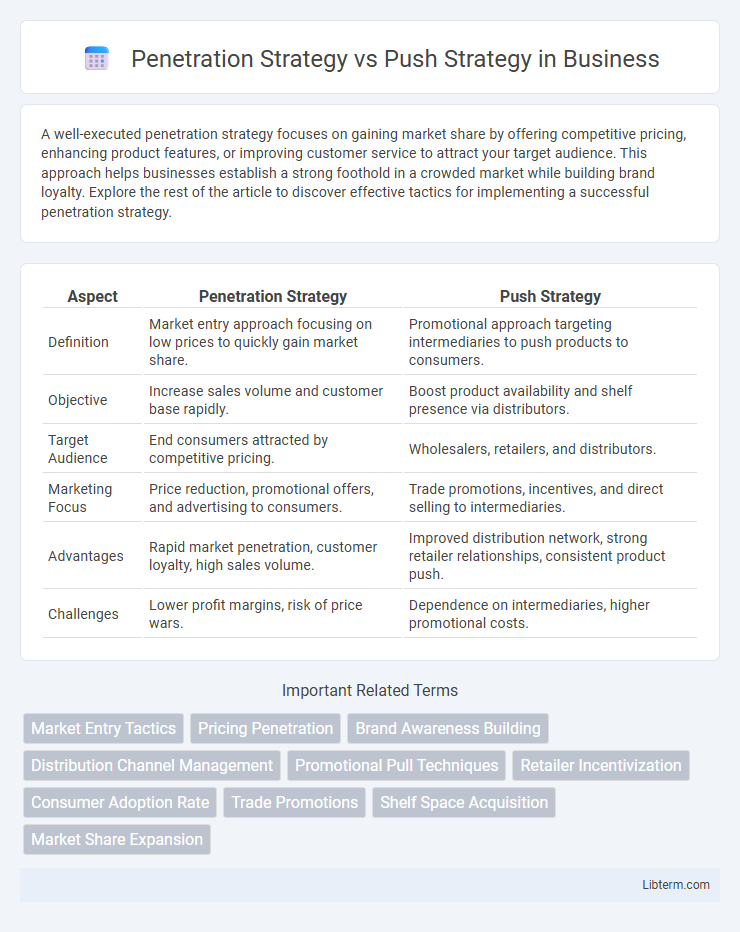A well-executed penetration strategy focuses on gaining market share by offering competitive pricing, enhancing product features, or improving customer service to attract your target audience. This approach helps businesses establish a strong foothold in a crowded market while building brand loyalty. Explore the rest of the article to discover effective tactics for implementing a successful penetration strategy.
Table of Comparison
| Aspect | Penetration Strategy | Push Strategy |
|---|---|---|
| Definition | Market entry approach focusing on low prices to quickly gain market share. | Promotional approach targeting intermediaries to push products to consumers. |
| Objective | Increase sales volume and customer base rapidly. | Boost product availability and shelf presence via distributors. |
| Target Audience | End consumers attracted by competitive pricing. | Wholesalers, retailers, and distributors. |
| Marketing Focus | Price reduction, promotional offers, and advertising to consumers. | Trade promotions, incentives, and direct selling to intermediaries. |
| Advantages | Rapid market penetration, customer loyalty, high sales volume. | Improved distribution network, strong retailer relationships, consistent product push. |
| Challenges | Lower profit margins, risk of price wars. | Dependence on intermediaries, higher promotional costs. |
Introduction to Penetration and Push Strategies
Penetration strategy aims to quickly gain market share by offering low prices or aggressive promotions to attract customers and discourage competition. Push strategy focuses on promoting products through intermediaries like wholesalers and retailers to push the product toward final consumers. Both strategies are crucial for market expansion but differ in targeting either the consumer directly (penetration) or distribution channels (push).
Defining Penetration Strategy
Penetration strategy emphasizes entering a market by offering lower prices or superior value to quickly gain market share and attract price-sensitive customers. The approach targets increasing product adoption through aggressive marketing, distribution, and promotional efforts to outpace competitors. This strategy aims to establish a strong presence early, leveraging volume sales and customer loyalty to achieve competitive advantage.
Defining Push Strategy
Push strategy involves promoting products by pushing them through distribution channels to end customers, emphasizing direct sales efforts, trade promotions, and personal selling. This approach targets intermediaries such as wholesalers and retailers to stock and sell the product, ensuring availability and visibility. It contrasts with penetration strategies by focusing on supply chain motivation rather than market pricing or consumer demand stimulation.
Key Differences Between Penetration and Push Strategies
Penetration strategy aims to quickly gain market share by offering low prices to attract a large customer base, whereas push strategy focuses on promoting products through intermediaries like wholesalers and retailers to push the product towards consumers. Penetration strategy prioritizes consumer demand generation through pricing, while push strategy emphasizes supply chain relationships and sales force incentives to drive product availability. The key difference lies in penetration targeting end consumers directly to stimulate demand, whereas push relies on convincing intermediaries to promote the product downstream.
Objectives of Penetration Strategy
Penetration strategy aims to quickly capture market share by offering low prices to attract customers and discourage competitors. The primary objectives include increasing product adoption, maximizing sales volume, and establishing a strong market presence early in the product lifecycle. This approach seeks to generate brand loyalty and achieve economies of scale for long-term profitability.
Objectives of Push Strategy
Push strategy aims to increase product availability and visibility by actively promoting products through the distribution channels to retailers and wholesalers. The objective is to persuade intermediaries to stock and sell the product, enhancing market penetration and driving short-term sales growth. This approach focuses on building strong relationships with channel partners to ensure product placement and promotional support in retail outlets.
Advantages of Penetration Strategy
Penetration strategy offers rapid market entry by setting low prices to attract a large customer base quickly, enhancing brand awareness and market share. It encourages customer loyalty through affordable pricing while discouraging competitors from entering due to reduced profit margins. This approach maximizes sales volume and leverages economies of scale, contributing to long-term profitability and competitive advantage.
Advantages of Push Strategy
Push strategy leverages direct promotion through sales channels, driving immediate product availability and visibility to consumers. It enables businesses to rapidly increase market penetration by incentivizing retailers and distributors to stock and promote products actively. This approach enhances supply chain control, reduces lead times, and ensures consistent product presence at the point of sale, leading to quicker sales cycles and efficient inventory turnover.
Choosing the Right Strategy for Your Business
Choosing the right strategy between penetration and push depends on your business goals and target market dynamics. Penetration strategy focuses on gaining market share by offering lower prices or increased value, ideal for price-sensitive markets or new product launches. Push strategy emphasizes aggressively promoting products through intermediaries or sales channels to drive demand, best suited for markets with established products and strong distribution networks.
Conclusion: Which Strategy Works Best?
Penetration strategy excels in rapidly increasing market share through aggressive pricing and promotion, ideal for competitive markets seeking quick growth. Push strategy focuses on building strong relationships with intermediaries, ensuring product availability and support, suited for products requiring channel cooperation and personal selling. The best strategy depends on market conditions and product type; penetration works well for fast adoption, while push is effective for complex sales and niche markets.
Penetration Strategy Infographic

 libterm.com
libterm.com